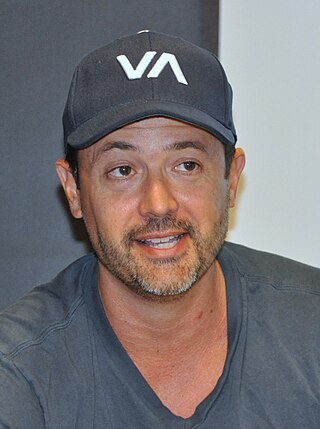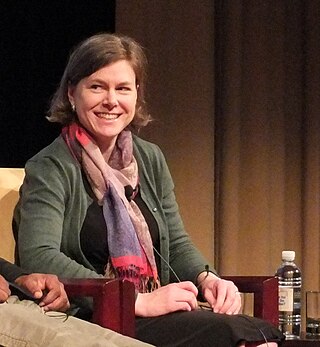
A cartoon is a type of visual art that is typically drawn, frequently animated, in an unrealistic or semi-realistic style. The specific meaning has evolved, but the modern usage usually refers to either: an image or series of images intended for satire, caricature, or humor; or a motion picture that relies on a sequence of illustrations for its animation. Someone who creates cartoons in the first sense is called a cartoonist, and in the second sense they are usually called an animator.

Charles Monroe "Sparky" Schulz was an American cartoonist, the creator of the comic strip Peanuts which features his two best-known characters, Charlie Brown and Snoopy. He is widely regarded as one of the most influential cartoonists in history, and cited by many cartoonists as a major influence, including Jim Davis, Murray Ball, Bill Watterson, Matt Groening, and Dav Pilkey.

Sword and sorcery (S&S) or heroic fantasy is a subgenre of fantasy characterized by sword-wielding heroes engaged in exciting and violent adventures. Elements of romance, magic, and the supernatural are also often present. Unlike works of high fantasy, the tales, though dramatic, focus on personal battles rather than world-endangering matters. Sword and sorcery commonly overlaps with heroic fantasy. The genre originated from the early-1930s works of Robert E. Howard. The term "sword and sorcery" was coined by Fritz Leiber in the May 1961 issue of the fantasy fanzine Amra, to describe Howard and the stories that were influenced by his works. In parallel with "sword and sorcery", the term "heroic fantasy" is used, although it is a more loosely defined genre.
Dan Perkins, better known by his pen name Tom Tomorrow, is an American editorial cartoonist. His weekly comic strip, This Modern World, which comments on current events, appears regularly in more than 80 newspapers across the United States and Canada as of 2015, as well as in The Nation, The Nib, Truthout, and the Daily Kos, where he was the former comics curator and now is a regular contributor. His work has appeared in The New York Times, The New Yorker, Spin, Mother Jones, Esquire, The Economist, Salon, The American Prospect, CREDO Action, and AlterNet.

Comics is a medium used to express ideas with images, often combined with text or other visual information. It typically takes the form of a sequence of panels of images. Textual devices such as speech balloons, captions, and onomatopoeia can indicate dialogue, narration, sound effects, or other information. There is no consensus among theorists and historians on a definition of comics; some emphasize the combination of images and text, some sequentiality or other image relations, and others historical aspects such as mass reproduction or the use of recurring characters. Cartooning and other forms of illustration are the most common image-making means in comics; Photo comics is a form that uses photographic images. Common forms include comic strips, editorial and gag cartoons, and comic books. Since the late 20th century, bound volumes such as graphic novels, comic albums, and tankōbon have become increasingly common, along with webcomics as well as scientific/medical comics.

Guy Berkeley "Berke" Breathed is an American cartoonist, children's book author, director, and screenwriter, known for his comic strips Bloom County, Outland, and Opus. Bloom County earned Breathed the Pulitzer Prize for Editorial Cartooning in 1987.

Stephan Thomas Pastis is an American cartoonist and former lawyer who is the creator of the comic strip Pearls Before Swine. He also writes children's chapter books, commencing with the release of Timmy Failure: Mistakes Were Made. The seventh book, It's the End When I Say It's the End, debuted at #4 on The New York Times Best Seller list for Children's Middle Grade Books.

Red Meat was a weekly three panel black-and-white comic strip by Max Cannon. First published in 1989, it has appeared in over 80 newspapers, mainly alternative weeklies and college papers in the United States and in other countries. It has been available online since November 1996.
Tom Terrific is a 1957–1959 animated series on American television, presented as part of the Captain Kangaroo children's television show.
"Moonbat" is a pejorative political epithet used in United States politics, referring to liberals, progressives, or leftists.

Howard Cruse was an American alternative cartoonist known for the exploration of gay themes in his comics. First coming to attention in the 1970s, during the underground comix movement with Barefootz, he was the founding editor of Gay Comix in 1980, created the gay-themed strip Wendel during the 1980s, and reached a more mainstream audience in 1995 when an imprint of DC Comics published his graphic novel Stuck Rubber Baby.

Thomas Gregory Toles is a retired American political cartoonist. He is the winner of the 1990 Pulitzer Prize for editorial cartooning. His cartoons typically presented progressive viewpoints. Similar to Oliphant's use of his character Punk, Toles also tended to include a small doodle, usually a small caricature of himself at his desk, in the margin of his strip.

Jen Sorensen is an American cartoonist and illustrator who creates a weekly comic strip that often focuses on current events from a liberal perspective. Her work has appeared on the websites Daily Kos, Splinter, The Nib, Politico, AlterNet, and Truthout; and has appeared in Ms. Magazine, The Progressive, and The Nation. It also appears in over 20 alternative newsweeklies throughout America. In 2014 she became the first woman to win the Herblock Prize, and in 2017 she was named a Pulitzer Finalist in Editorial Cartooning.

John Ross "Dok" Hager was an American cartoonist for the Seattle Daily Times, creator of a daily comic accompanying the weather report, and the comic strip Dok's Dippy Duck. Hager's nickname stems from his time as a dentist in Terre Haute, Indiana before he moved to Seattle, Washington in 1889 and began working for the Seattle Times. Hager retired in 1925 due to blindness.
Robert Thaves was the creator of the comic strip Frank and Ernest, which began in 1972.

The works of William Gibson encompass literature, journalism, acting, recitation, and performance art. Primarily renowned as a novelist and short fiction writer in the cyberpunk milieu, Gibson invented the metaphor of cyberspace in "Burning Chrome" (1982) and emerged from obscurity in 1984 with the publication of his debut novel Neuromancer. Gibson's early short fiction is recognized as cyberpunk's finest work, effectively renovating the science fiction genre which had been hitherto considered widely insignificant.

Comics journalism is a form of journalism that covers news or nonfiction events using the framework of comics, a combination of words and drawn images. Typically, sources are actual people featured in each story, and word balloons are actual quotes. The term "comics journalism" was coined by one of its most notable practitioners, Joe Sacco. Other terms for the practice include "graphic journalism," "comic strip journalism", "cartoon journalism", "cartoon reporting", "comics reportage", "journalistic comics", and "sketchbook reports".

The Phoenix is a British weekly story comic for children aged 7– 14, published by David Fickling Comics Ltd. The comic was launched on 7 January 2012 with a preview issue which was released in late 2011. The comic is often considered a successor to The DFC: both are published by the same people and many of The Phoenix's creators had worked on The DFC.
The history of American comics began in the 19th century in mass print media, in the era of sensationalist journalism, where newspaper comics served as further entertainment for mass readership. In the 20th century, comics became an autonomous art medium and an integral part of American culture.

Mattie Lubchansky is a cartoonist and illustrator from the United States, who specializes in satirical comics about American politics. Lubchansky is non-binary and uses they/them pronouns since 2017.















